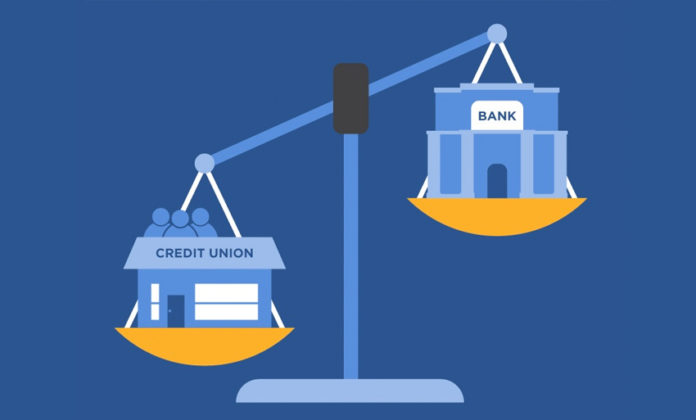The banking industry is notoriously competitive. That means financial institutions must offer an array of services at various rates with different levels of convenience and structure. Credit unions and traditional banks each have their pros and cons. After analyzing the value proposition of credit unions vs. banks, a consumer may benefit in switching from one to the other. While there may be some crossover between the advantages of each type of institution, there are few notable differences that can determine which one a customer may choose.
The Bank Customer
Takes Advantage of Rewards
Greg McBride, the senior financial analyst for Bankrate, believes that in terms of rewards programs (points, miles, etc.) traditional banks have cornered the market.
Consumers who pay off their balance each month know the value of a good rewards program, and according to McBride, “The credit card market continues to be dominated by large national bank issuers that often have generous reward programs and sign-up bonuses.”
If a credit union customer is wanting to stack up points, travels and accrues miles, they may want to look at switching to a traditional bank that will be more likely to compensate them for their frequent activity.
Is Concerned with Convenience and Eligibility
Shopping for a bank is different from shopping for a CU in many ways, and one of those ways is eligibility. A consumer may really like the products and services offered by the Integrus Credit Union in Dubuque, Iowa. However, if they are not a resident of one of 14 counties in Iowa, Wisconsin or Northern Illinois, then that consumer is not going to be able to join. If a consumer is using a regional credit union but relocates often, they may be drawn to the more universal appeal of a traditional bank.
The number of credit unions in the United States has dropped 40% in the last decade. 546 credit union institutions closed in just one year (2014). It may be difficult for certain consumers to find a credit union that they can join that has the services that are important to them. The customer who foresees a career change or are involved in an industry specific credit union, might want to look at banks to alleviate future eligibility issues. Credit unions are selective in both of these regards, and an eligible customer can soon become ineligible with certain life events.
While credit unions are starting to catch up with the technology of big banks (online banking, greater ATM access, etc.) they are still behind. A customer may prefer a bank over a credit union for matters of convenience. For instance, if a credit union customer is planning on regular international travel, they might consider transferring their business to a big bank. Finding ATMs or branch access can be much more convenient when using a traditional big bank as opposed to a credit union, and banks usually offer more user-friendly services for currency conversion. Accessibility may also come at a price. When traveling to an area where a credit union does not have an ATM, there may be high surcharges to withdraw funds from third-party machines.
Needs a Variety of Financial Products
A consumer with a checking and savings account, as well as a small loan with a credit union may find themselves outgrowing the services offered at their current institution. If the consumer plans on starting a small business or multiple investment accounts for instance, they may need to switch to a bank with a more robust variety of services. As an example, Coastal Heritage Bank offers customers 4 different types of personal checking accounts along with an array of business banking solutions that most credit unions would not provide.
The Credit Union Consumer
Needs Lower Interest Rates on Loans
Unlike commercial banks, credit unions are non-profit institutions. This means they will generally have lower interest rates on loans. While traditional banks may offer more complex investment services, a consumer looking for a short-term car or home loan may decide to switch from a bank to a CU to keep the interest of the loan lower. In addition, consumers with a credit card balance or a student loan could benefit from a transfer to a credit union for a lower interest rate.
As an example, Lendkey offers student loan refinancing through CUs. According to Alice Stevens, COO of First Financial Credit Union, banks have left some borrowers holding student loan interest rates of up to 14%. Through Lendkey’s student loan consolidation program, rates may range from 4.25% to 7.25%.
Does Not Want to Be Handcuffed by Fees
Most banks charge a monthly maintenance fee for checking accounts. They also charge fees for things like minimum balance and minimum daily balance. Consumers may wish to escape these fees by switching to a credit union. More than 70% of the largest credit unions offer free checking. That’s opposed to only 39% of traditional banks.
About 1 out of 4 commercial banks offer free checking accounts. According to the latest money-rates.com checking account fee survey, Americans pay an average of $159 a year for checking with traditional banks. A consumer may choose to switch to a CU to avoid those fees and place the same amount into a high-yield/low risk savings account with their new institution.
Appreciates Leveling up Their Financial Literacy
Credit unions pride themselves on being arbiters of financial information. While commercial banks may offer the services of advisors or bankers, data from Kehrer Bielan Research and Consultingshows us that credit unions currently score the win in this category. Their study found that “gross investment services revenue per CU advisor rose by 16% from 2013 to 2014; for advisors at bank owned broker-dealers that number was just 6%.”
Credit unions do their best to make it easy for a consumer to make the switch from traditional banks. Many offer “switch kits” to walk the customer through the process. Likewise, traditional banks invest heavily in new customer acquisition and usually have help on staff to make the transition to their institution hassle-free.
Depending on the services customers need and the options available to them, the pros and cons of switching from a bank to a credit union (or vice versa) are individual and not universal. With the many options on the market these days, some people are even choosing to use both options for different accounts and different purposes. There is a saying in the financial services industry that “the only constant is change.” The institutions that will excel moving forward will be the ones that can adapt to the ever changing requirements of the consumer.





